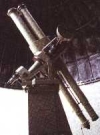
Zeiss Astrograph
The Zeiss telescope is an astrograph with a 20 cm diameter and a 114 cm focal length dates back to the 1920s. But in the 1960s the camera lens was replaced with a quadruplet (the previous one was a triplet).
The camera lens was chosen so that the scale is exactly 2 cm per degree and to match that of Argelander’s large visual atlas.
The main feature of the instrument, designed for the light blue region of the spectrum, is the large corrected field (up to 4° from the optical axis). The instrument was mainly used for the study and search for asteroids until the mid-1980s. Although the dome that houses it has only 5 meters in diameter, from then on it has been used for teaching, using the 13 cm diameter guide-scope with a 170 cm focal length.
Astrometric Reflector Reosc
This is the most modern telescope the observatory has, with a primary mirror with a diameter of 105 cm and a focus length a bit short of 10 m. Built in 1974, it has remained constantly active with traditional instruments (photo camera, photoelectric photometer) until the early 90s!
In 1994 a CCD camera, with an EEV sensor and front illuminated by 1242×1152 25micrometer pixels, was made available with a cryostat and control software from Astromed of Cambridge (UK).
The Observatory designed and built two new sections: the telescope optical unit interface, the guide camera handling system and filter holder wheel unit.
Morais Refractor
The double photographic and visual refractor Morais (the name from the optic engineer that designed the lenses) is in the dome built in 1910/12 for the Merz refractor.
The lenses (triplets with a smaller secondary spectrum) have an opening of 42cm visual and a 38 cm photographic, with a focus of about 7 m for both. The instrument has under gone multiple restorations, the current configuration dates back to 1982, when a new mount, to sustain a pair of parallel optical tubes, was installed.
The photographic refractor was mostly used in the past for multiple photographic astrometry program, meanwhile, the visual refractor, the biggest in Italy, was used for micrometric measures of binary visuals and as a guide telescope for the photographic part.



